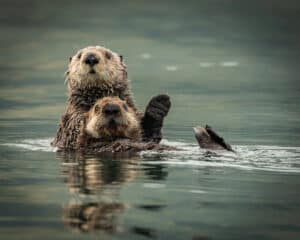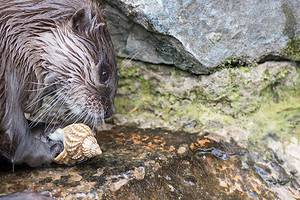The sea otter, or Enhydra lutris, is a species of marine mammal that is endemic to the shores of the Eastern North and Northern Pacific. The family Mustelidae comprises 13 different kinds of otters as well as terrestrial creatures like badgers, minks, and weasels. The sea otter is the biggest member of this family (the giant otter is longer but substantially slimmer). For example, sea otters are a prime example of a keystone species because of the outsized impact their existence has on the environment.
The population of some herbivorous benthic (sea bottom creatures, such as sea urchins), are kept in check by sea otters. Something new can be discovered about these cute animals all the time. They’re crucial to the health of coastal ecosystems and adorable beyond belief. Explore below to meet the 5 cutest sea otters in the world!
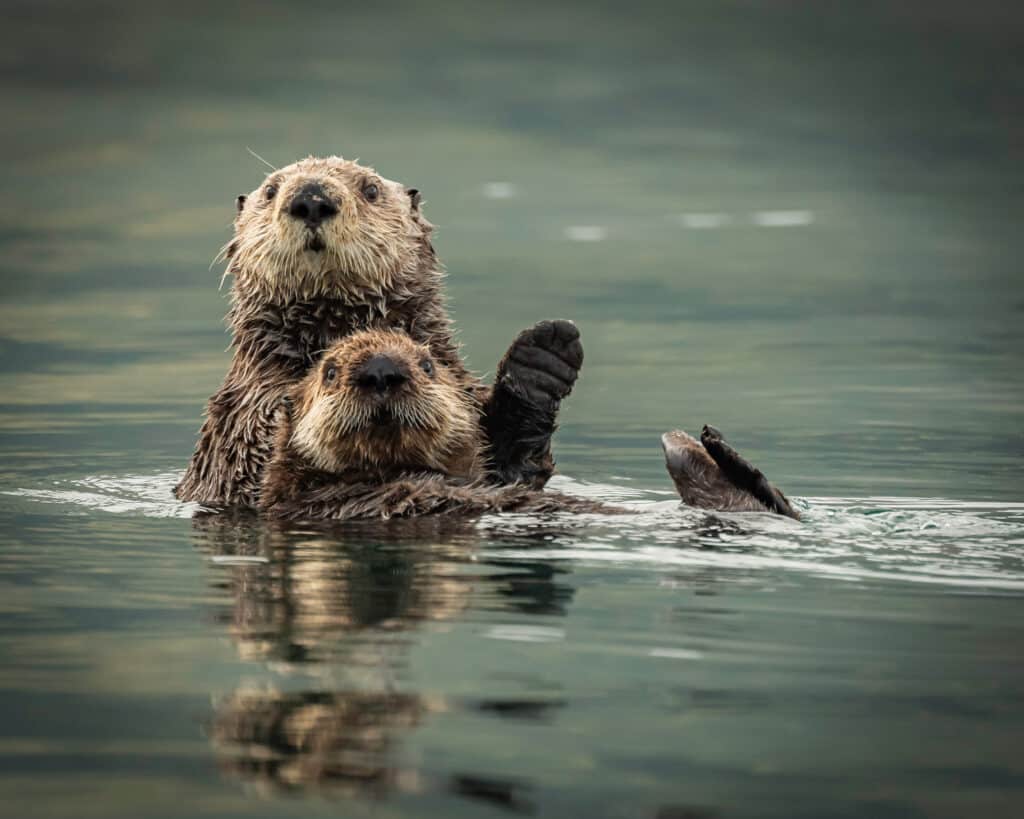
Sea Otters in Kodiak Alaska – The majority of sea otters call Alaska home.
©Laura Hedien/Shutterstock.com
1. Luna
A walker along Coastways Beach in central California overheard the now-famous southern sea otter, Luna, making a distress call. Santa Cruz is not far away. The Sea Otter Program at the Monterey Bay Aquarium took in the malnourished infant, weighing just two pounds, and began feeding it to health. Pup 681 was saved when she was just five days old, making her the almost 700th sea otter to be cared for in the program’s three decades of existence.
The orphaned otter, after spending many weeks at the Monterey Bay Aquarium in California, is now living at the Shedd Aquarium in Chicago. She is one of the cutest sea otters.
2. Eddie
When Eddie the sea otter, a celebrity who went viral in 2013, died, he was just 20 years old. A young otter found abandoned in California’s wild was rescued by animal activists in 1998. After undergoing rehabilitation at a marine facility in Monterey, he was sent to the Oregon Zoo in Eugene. Eddie’s home zoo, the Oregon Zoo, reported he was put to sleep due to declining health. Eddie was considered to be among the oldest of his kind.
Several years ago, the animal went viral after a video of him slam-dunking a miniature basketball over a little hoop was posted online. The zoo that cares for him says they taught him the activity to ease the pain of arthritis in his joints as he became older. The zoo’s marine life supervisor, Amy Cutting, said in a statement that Eddie was “among the very oldest of his species.” Male sea otters typically don’t live much longer than 15 years.
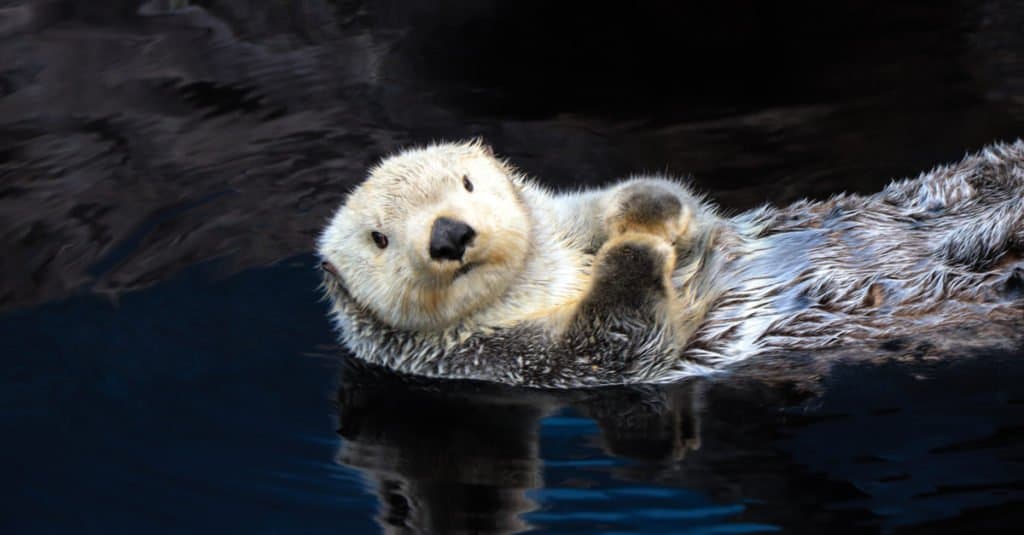
Sea Otters love floating on their backs.
©nvphoto/Shutterstock.com
3. Ruby
Little Ruby, or Otter 714, is one of the cutest sea otters. She was abandoned as a young in the area of San Simeon in the fall of 2015. She was among the tiniest sea otters rescued, weighing only 1.9 pounds (0.86 kg). The Animal Care staff at the Monterey Bay Aquarium rescued her the same day they saw her because they were concerned that she might have been born early due to her small size and new belly button.
Formerly an exhibit animal, Gidget the sea otter gave birth to Ruby as part of their surrogacy program. Elkhorn Slough now has an otter cub that was released there. She was tried to be released into the wild multiple times, but her dependence on human food led to her being deemed non-releasable by the U.S. Fish and Wildlife Service.
The Aquarium of the Americas in New Orleans, Louisiana, offered her a permanent home in March 2017. She was a representative of her species and a friend to Clara, an otter who was there for eight years. It was decided by more than 3,000 voters that she would be called Ruby, because of her favorite toy which was a bright red ball. Ruby moved in with the other permanent otters at the Monterey Bay Aquarium in July 2022.
4. Toola
Even though Toola didn’t become famous overnight, she left quite an effect on the employees at the Monterey Bay Aquarium, wherein she spent the majority of her adult life. There had never been a surrogate mother from a captive otter until Toola. And that shifted how scientists handled recuperating wounded otters.
Previously, otters that had been raised with people could not be released back into the wild. Thanks in large part to Toola, legislation was enacted to establish the California Sea Otter Fund, which funds studies of “disease and other hazards facing sea otters in the wild.” In 2012, Toola succumbed to old age. Her age was estimated to be between 15 and 16.

Sea otters are equipped with webbed feet and fur that repels water which helps keep them warm.
5. Ivy
Ivy, a two-week-old puppy, was discovered abandoned in the late fall of 2011 on Cayucos State Beach in San Luis Obispo County. The Sea Otter Program at the Monterey Bay Aquarium raised and cared for her for seven weeks before introducing her to Toola, the aquarium’s most seasoned surrogate mother. Ivy was deemed non-releasable by the U.S. Fish and Wildlife Service after a number of issues prevented her early release.
One year ago, in December 2012, Ivy formally became a part of the sea otter exhibition as a surrogate mother to pups. Trainers at the Aquarium have called her a “wild child” due to her enthusiasm and curiosity. She is also one of the cutest sea otters.
6. Kit
Kit, then just five weeks old, was discovered in January 2010 in the Morro Bay Harbor. After being rescued by a scientist with the California Department of Fish and Wildlife, she was not returned to the wild without first obtaining permission from the United States Fish and Wildlife Service. Kit, a juvenile sea otter born in 2010, became the aquarium’s youngest-ever show animal when she was just 11 weeks old. While at the aquarium, Kit learned essential otter abilities including opening clams and consuming live crab while avoiding getting bit. Her move to SeaWorld San Diego in June 2012 let her continue growing up and becoming used to interacting with other show species.
At the age of three in January 2013, Kit made her way back to the Aquarium. She served as a surrogate mother and teacher to the puppies in the back. In honor of a character from John Steinbeck’s The Wayward Bus, the chocolate-brown otter is one of the largest of these animals at around 50 pounds!
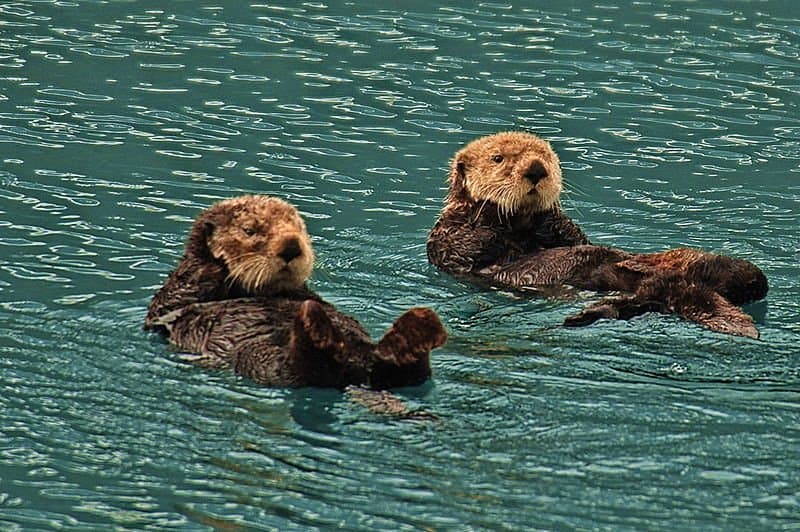
Polygamy is a common behavior among marine mammals, and sea otters are no exception.
7. Rosa
Of the sea otters at the Monterey Bay Aquarium, Rosa is the eldest and one of the cutest sea otters. In September of 1999, at the tender age of four weeks and weighing just around five pounds, she was discovered abandoned near Sunset and Manresa State Beaches in southern Santa Cruz County. She returned to the wild in April of 2000. She spent almost two years there before she started playing with divers and hopping into kayaks. Federal wildlife inspectors deemed her non-releasable due to the risks she posed to herself and humans.
On June 1, 2002, Rosa became a member of the sea otter display. She has put her maternal instincts to good use throughout her time at the Aquarium. Rosa has raised more puppies than any of the other active surrogate mothers currently on display. She stands out as one of the larger and more striking otters because of her silvery head fur and white freckles. Whenever she’s finished eating, she goes to the central window to chill out on the water’s surface.
8. Selka
When Selka was just a week old, she was discovered abandoned on the coast of Cayucos, California. She was taken care of at Monterey Bay Aquarium, and in June 2013, she was released back into the wild. Tragically, she was discovered pulled out in Moss Landing Harbor with horrific shark bite injuries eight weeks after her release. Once she had recovered from her ordeal at the Aquarium, she was released back into the wild after four months. Selka was returned to the aquarium after many months in the wild due to health issues and numerous contacts with humans. The United States Fish and Wildlife Agency ruled that she could not be released back into the wild. Selka then spent the next couple of years at Long Marine Lab. There, she contributed to the study of how wild sea otters find and consume enough food to sustain themselves in the water.
In August 2016, Selka became a permanent exhibit member at the Monterey Bay Aquarium. She is bright, kind, and curious. Selka is the second youngest of their otters, and her chocolaty brown fur makes her stand out from the crowd. It has been established that she is a reliable surrogate mother behind the scenes.
The photo featured at the top of this post is © iStock.com/David McGowen
Thank you for reading! Have some feedback for us? Contact the AZ Animals editorial team.



